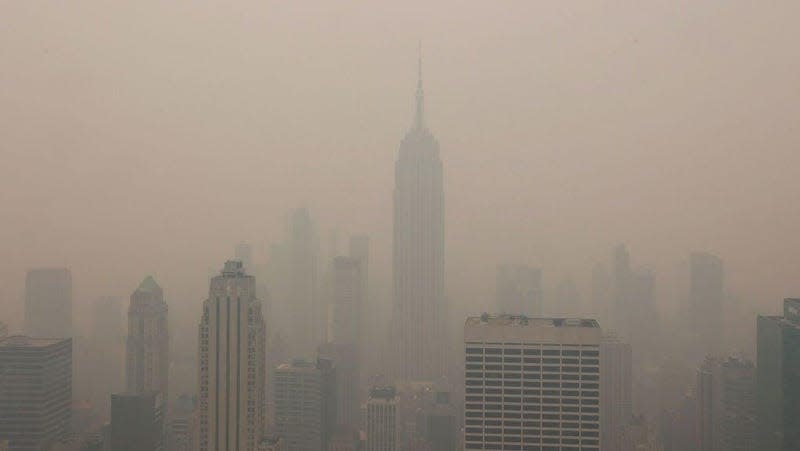Headed to 'Potential Collapse': Alarm Bells Are Blaring in New Climate Report

Midtown Manhattan buildings are shrouded in smoke from Canadian wildfires on June 7, 2023.
Global climate extremes are adding up, and scientists are warning with renewed urgency that both natural and human systems are at risk of collapse. In a new report published in the journal BioScience, researchers analyze what they describe as 35 planetary vital signs used to track climate change. They found that 20 of the 35 signs are at new extremes. While most of those are bad records, a few actually represent positive steps.
The vital signs, which include things like ice sheet melt, greenhouse gas emissions, meat production, tree cover loss, and billion-dollar flood events, highlight the interconnectedness of the climate crisis. For example, the report references the rate of ice loss in Greenland, which in turn contributes to sea level rise. Other records include our ever-rising methane emissions and carbon dioxide emissions; meanwhile, fossil fuel subsidies (another vital sign they tracked) are at an all-time high. Experts warn the world must scale back fossil fuel infrastructure to stop the planet from hitting 1.5 degrees of warming above preindustrial levels.
Read more
5 Disappointing Things About Konami’s Metal Gear Solid 'Master Collection'
Watch This Massive Tow Truck Roll Three Times After Hitting Suspected Distracted Driver
Reservation Dogs star Devery Jacobs wasn't a fan of Killers Of The Flower Moon
Turo Wants Customer To Pay $35,000 After Vandals Smash His Rented Car’s Windows
Back in 2019, Ripple and many other concerned climate scientists published another paper on the climate emergency. That report outlined six areas where policymakers could take more action, including restoring ecosystems and cutting a range of emissions. Ripple says he expected climate change-related extremes to continue to increase over time since then. But some moments in 2023 shocked him, like seeing images of the New York City skyline shrouded in smoke from Canadian wildfires. Or learning that so much smoke was produced, it broke pollution records in just a few months.
“The number of wildfires and the smoke. It is quite jarring,” he said. “The area that burned in Canada is off the charts.”
A small handful of the records in the list of 20 vital signs are actually positive. Study authors pointed out that about $39 trillion was divested or pledged to be divested from the fossil fuel industry in 2021. The consumption of renewable energy from wind and solar grew about 17% between 2021 and 2022. However, it is still several times less than fossil fuel energy consumption worldwide, according to the report.
The report also notes that more than 2,000 country, regional, and city governments have declared climate emergencies, which counterintuitively is cause for some tentative hope, Ripple told Earther. “The first thing about addressing any big problem is to admit to it and raise awareness,” he said.
The new report emphasizes that our financial and energy systems are the problem—not simply the number of people (8 billion) on the planet. Wealthy individuals and wealthy nations emit so much more than everyone else, by using private jets and living in larger, multiple homes that guzzle water during droughts. “We therefore need to change our economy to a system that supports meeting basic needs for all people instead of excessive consumption by the wealthy,” the study authors wrote.
“Climate justice and social justice topics need to be part of the discussion for both climate mitigation and climate adaptation,” Ripple said.
Want more climate and environment stories? Check out Earther’s guides to decarbonizing your home, divesting from fossil fuels, packing a disaster go bag, and overcoming climate dread. And don’t miss our coverage of the latest IEA report on clean energy, the future of carbon dioxide removal, and the invasive plants you should rip to shreds.
More from Gizmodo
Paramount delays the next Mission: Impossible, which is no longer called Dead Reckoning: Part Two
Final Fantasy VII Rebirth Devs Have A Big Surprise Planned For Its Most Iconic Scene
Are Fed up Customers Sending Greedy Hair Stylists Back to 9 to 5 Jobs! Tiktok Says "Yes!"
It Looks Like The Next Gen Dodge Charger Will Get A Gas Engine After All
Sign up for Gizmodo's Newsletter. For the latest news, Facebook, Twitter and Instagram.

